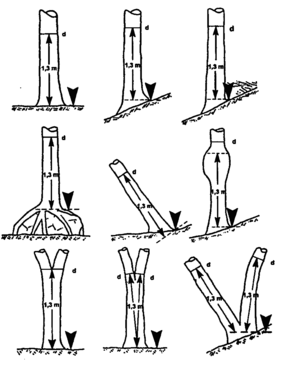Diameter at breast height
The standard position for diameter measurements at standing trees is at breast height, defined at the height of 1.30m in most countries. But there are many countries where diameter at breast height is measured at different heights. Therefore, it is always good to find out where dbh is measured before engaging in data analysis. In the United States, for example, dbh is taken at 4.5 feet above ground which is about 1.37m, and in Korea at 1.20m. The reason why breast height developed to be a standard measure has probably to do with the ease and convenience of measurement.
Rules

However, irregularities and anomalies of tree stems do some times prevent the measurement of a diameter at the defined height. For these cases, rules need to be defined how to proceed. This is usually done with graphs describing these specific situations and how to proceed then with the dbh measurements. It is important that all field teams who carry out the measurements follow the same definitions and instructions. In the following, some typical situations are listed and how the dbh measurements are then usually taken:
- Tree on slope: If a tree is in a sloped terrain, the dbh is measured at the standard height above the forest floor on the uphill side of the tree.
- While measuring the breast height from the ground level, we have to pay attention that the level from which is measured is in fact the ground and not the surface of a heap of woody debris.
- If the tree is leaning, breast height is measured parallel to the lean on the top side of the tree, whereas diameter is measured perpendicular to the longitudinal axis of the trunk.
- In case of buttressed tree, if the height of the buttress is more than 1m, then the breast height is measured from the point where buttress ends. In this case, reduction models are some times be applied with which the would-be diameter at breast height is estimated from the measurement of a diameter at another height.
- When there is an abnormality at breast height such as crooks, swelling or knots, the dbh is measured above or below the abnormality. Some times, the rule is defined that diameter measurements are then done at equal distances above and below breast height and dbh then estimated by simply taking the mean of the two measurements.
- If a tree bifurcates above breast height, then one measures dbh as usual. If the bifurcation is below breast height, each stem is measured and counted separately.
Instruments for measuring diameter at breast height
The most commonly used instruments for measuring diameters at breast height are calipers and diameter tapes. Other instruments are interesting in principle but relatively little used; examples are the Biltmore stick and Bitterlich´s sector fork. Though some of these instruments may be used to measure diameters at other defined points of the tree, there are other instruments that are more efficient for this purpose such as optical calipers.
References
- ↑ BMELV. 2007. Survey Instructions for the 2nd National Forest Inventory (2001-2002). Reprint February 2007 2nd corrected translation February 2006, of the 2nd corrected and revised reprint, May 2001. 106